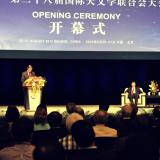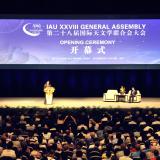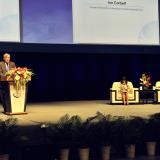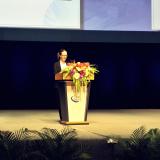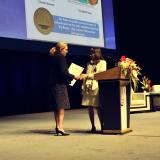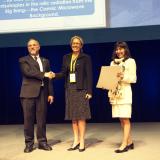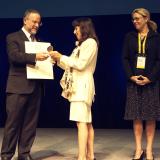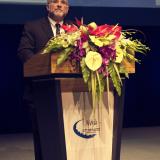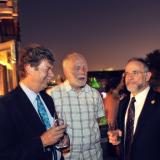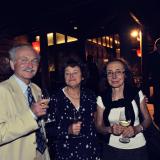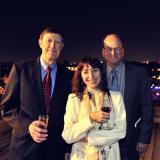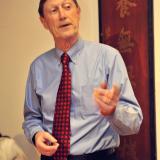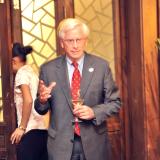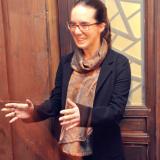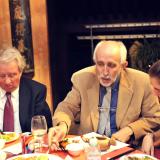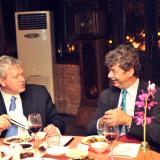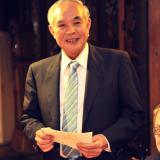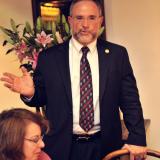2012 Gruber Cosmology Prize
2012 Cosmology Prize Recipient
Laureate Profile
On April 23, 1992, the Cosmic Background Explorer (COBE) team released a result that astronomers and physicists had long anticipated: validation for the Big Bang theory. It came in the form of temperature fluctuations dating to when the universe was 378,000 years old, a fossil imprint of all the mass and energy in the universe—everything that would evolve into the universe we see today.
“It was clear to everybody in the field that it needed to be followed up,” says Charles L. Bennett, deputy principal investigator on COBE. Bennett, then at NASA and now at Johns Hopkins, would soon become the principal investigator on a successor satellite mission, the Microwave Anisotropy Map, or MAP—so named because, like COBE, it would provide a map of the infant universe. (“Anisotropy” refers to “having a different value when measured in different directions” – in this case temperature fluctuations across the sky in the relic radiation.)
“The building of the hardware,” Bennett says, “was extraordinarily stressful for me because I felt enormous personal responsibility for spending $100 million correctly.” Bennett recalls receiving phone calls on a nearly daily basis from team members, all of which began with some variation on “Chuck, we have a problem.” After two or three months, he says, he realized that such was the nature of the project. “I had a talk with myself,” he says. “I realized that the disastrous problem of the day was not the same disastrous problem as yesterday. That meant that we were solving problems and moving forward. It would be like this as we made progress until we launched.”
On June 30, 2001, the MAP satellite was launched into orbit—on schedule and on budget. The data analysis, Bennett recalls, went relatively smoothly and quickly—but only because the team adopted a “Sleep Is For Wimps” slogan.
David Wilkinson, a Princeton experimentalist who had been a key player on COBE and who had continued to collaborate closely with Bennett on WMAP, died of cancer on September 5, 2002. “He didn’t live long enough for the first data release,” Bennett says, “but he lived long enough to see the beginnings of maps forming and he saw the high quality of the data, and he was delighted by that.” The team successfully petitioned NASA to change the name of the mission to the Wilkinson Microwave Anisotropy Probe.
On February 11, 2003, the WMAP team had their own COBE moment: the public release of the analysis of the first year’s worth of data, a trove that transformed cosmology by confronting ideas with data of unprecedented precision. This transformational WMAP data convinced even skeptics that the odd combination of dark energy and dark matter are required by compelling data.
Since then the WMAP team has further improved those results in two-year increments. Having eventually reached the point of diminishing returns, the WMAP team opted to stop collecting data in August 2010. But its contributions will endure in the history of science as the Standard Cosmological Model. WMAP determined cosmological parameters with an overall factor of more than 30,000 times better precision than previous data. The universe according to WMAP is 13.75 billion years old (to within 1 percent); it consists of 22.7 percent dark matter, 72.8 percent dark energy, and only 4.6 percent regular matter (such as atoms); its geometry is flat to within 0.6 percent; and it very likely went through a period of extraordinary expansion called inflation in the first fraction of a second of its existence. WMAP placed the first meaningful constraints on the range of acceptable versions of inflation.
Watch Video
Citation
The Gruber Foundation proudly presents the 2012 Cosmology Prize to Charles Bennett and the Wilkinson Microwave Anisotropy Probe team for their exquisite measurements of anisotropies in the relic radiation from the Big Bang---the Cosmic Microwave Background. These measurements have helped to secure rigorous constraints on the origin, content, age, and geometry of the Universe, transforming our current paradigm of structure formation from appealing scenario into precise science.
THE WMAP TEAM:
CHRIS BARNES, RACHEL BEAN, OLIVIER DORÉ, JOANNA DUNKLEY, BENJAMIN M. GOLD, MICHAEL GREASON, MARK HALPERN, ROBERT HILL, GARY F. HINSHAW, NORMAN JAROSIK, ALAN KOGUT, EIICHIRO KOMATSU, DAVID LARSON, MICHELE LIMON, STEPHAN S. MEYER, MICHAEL R. NOLTA, NILS ODEGARD, LYMAN PAGE, HIRANYA V. PEIRIS, KENDRICK SMITH, DAVID N. SPERGEL, GREG S. TUCKER, LICIA VERDE, JANET L. WEILAND, EDWARD WOLLACK, EDWARD L. WRIGHT



